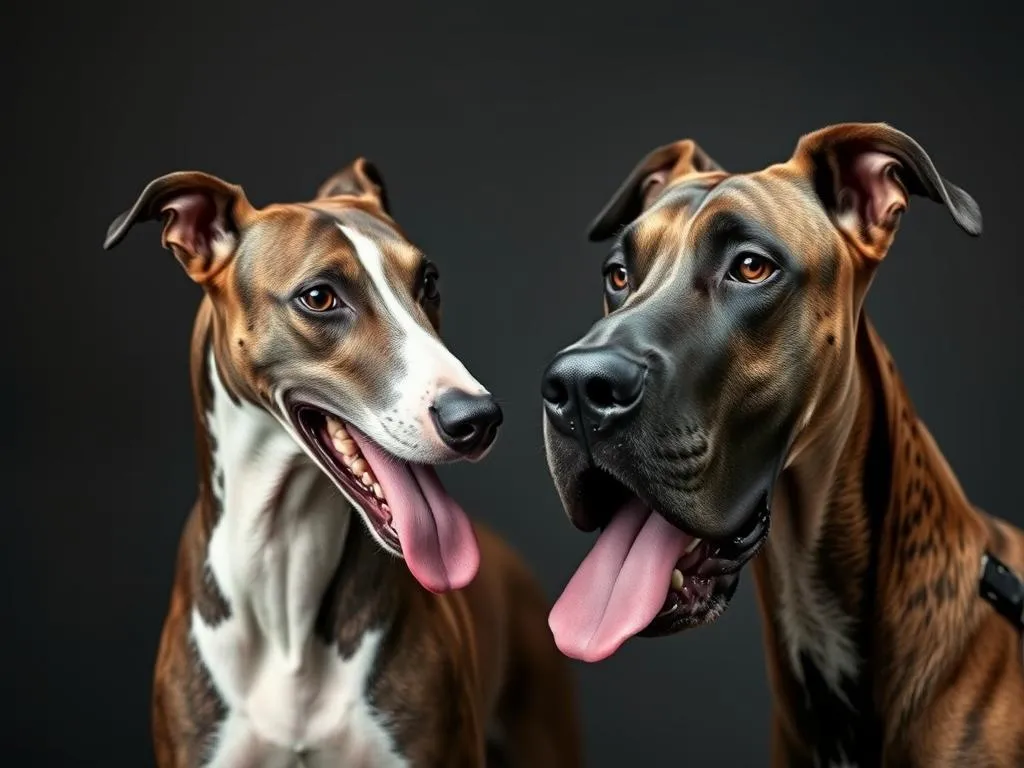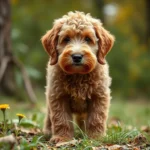
Choosing the right dog breed is a vital decision that can significantly impact your lifestyle and home dynamics. Two breeds that often capture the attention of potential dog owners are the Greyhound and the Great Dane. While both breeds are renowned for their unique characteristics and histories, they differ in numerous aspects. In this article, we will delve into a comprehensive comparison of these two fascinating breeds, examining their origins, physical traits, exercise needs, health considerations, grooming requirements, and more.
Breed Overview
Greyhound
The Greyhound is one of the oldest dog breeds, with a history tracing back to ancient Egypt. Recognized for their incredible speed and agility, Greyhounds were originally bred for hunting game. They are known for their slim, athletic build, with an elongated head and deep chest, making them one of the fastest dog breeds, capable of reaching speeds up to 45 miles per hour.
In terms of physical characteristics, Greyhounds typically stand between 25 to 30 inches tall at the shoulder and weigh approximately 60 to 70 pounds. Their short coat is smooth and comes in a variety of colors, including fawn, black, blue, and brindle. Temperamentally, Greyhounds are gentle, affectionate, and often referred to as “couch potatoes” due to their love for lounging after short bursts of exercise.
Great Dane
The Great Dane, known as the “Apollo of dogs,” is recognized for its gigantic stature and friendly demeanor. Originating in Germany, these dogs were initially bred for hunting large game, such as boar and deer. Despite their imposing size, Great Danes are known for their gentle and friendly nature, making them excellent companions.
Great Danes typically stand between 28 to 34 inches tall and can weigh anywhere from 110 to 175 pounds. Their coat is short and comes in a variety of colors, including fawn, brindle, blue, and harlequin. Personality-wise, Great Danes are known for their loyalty, playfulness, and calm demeanor, making them suitable for families.
Size and Weight Comparison
Greyhound Size
Greyhounds are classified as medium to large-sized dogs. They generally have a height ranging from 25 to 30 inches and weigh between 60 to 70 pounds. Compared to other medium-sized breeds, they are taller and sleeker, which contributes to their impressive speed and agility.
Great Dane Size
In stark contrast, Great Danes are one of the largest dog breeds. They can reach heights of 28 to 34 inches and can weigh over 175 pounds. Their sheer size places them in the giant breed category, making them significantly larger than Greyhounds.
Size Implications
When considering size, it’s essential to think about space requirements. Greyhounds can adapt well to both apartments and houses, given their relatively moderate exercise needs. Conversely, Great Danes require more living space due to their size and may struggle in smaller settings. This distinction is crucial for prospective owners to consider, particularly in urban environments.
Exercise and Activity Levels
Exercise Needs of Greyhounds
Despite their sprinter-like speed, Greyhounds have moderate exercise needs. A daily walk of 30 minutes to an hour combined with short bursts of playtime is generally sufficient. Ideal activities include jogging, playing fetch, and even lure coursing, which allows them to utilize their natural hunting instincts.
Exercise Needs of Great Danes
Great Danes, on the other hand, require more structured exercise to maintain their health. They typically need at least an hour of exercise daily, which can include walks, playtime, and socialization with other dogs. Activities like gentle hiking or swimming can also be beneficial, as they help to strengthen their muscles without putting too much strain on their joints.
Comparison of Exercise Needs
In comparing their energy levels, Greyhounds are somewhat more relaxed and enjoy lounging around the house, while Great Danes are more active and require consistent engagement. For active families, a Great Dane may be a better fit, while Greyhounds might suit a more sedentary household.
Health Considerations
Common Health Issues in Greyhounds
Greyhounds are generally healthy dogs but can be prone to certain genetic conditions, including hip dysplasia, bloat, and certain heart issues. Their lifespan averages around 10 to 14 years. Preventive health care, including regular veterinary check-ups and a balanced diet, is crucial for maintaining their health.
Common Health Issues in Great Danes
Great Danes are also susceptible to specific health issues, notably hip dysplasia, bloat (gastric torsion), and heart disease. Their lifespan tends to be shorter, averaging 7 to 10 years. Due to their size, weight management and regular vet visits are essential to prevent health complications.
Preventative Care
Both breeds benefit from routine veterinary care. Regular check-ups, vaccinations, and dental care are vital. Additionally, maintaining a proper diet tailored to each breed’s specific needs can help mitigate health risks.
Grooming and Maintenance
Grooming Needs of Greyhounds
Greyhounds have low grooming needs due to their short coat. They shed minimally and require occasional brushing to remove loose hair. Bathing can be done as needed, typically every few months. Basic grooming tools include a rubber brush and a gentle shampoo.
Grooming Needs of Great Danes
Great Danes also have low grooming requirements, with their short coat requiring occasional brushing. They shed moderately, and regular brushing can help control hair around the home. Bathing can be done every few months or as necessary, depending on their activity level.
Comparison of Grooming Requirements
Both breeds require minimal grooming, making them relatively low-maintenance in terms of coat care. However, the larger size of Great Danes may lead to higher grooming costs due to the amount of shampoo and the need for larger grooming tools.
Training and Socialization
Training Greyhounds
Greyhounds are intelligent and eager to please, which makes them relatively easy to train. However, they can exhibit some stubbornness. Positive reinforcement training methods, including treats and praise, work best. Early socialization is crucial to help them become well-rounded companions.
Training Great Danes
Great Danes are also intelligent and trainable but may require more consistent leadership due to their size. Early socialization is equally important, as they need to learn how to interact gently with people and other animals. Using positive reinforcement, such as treats and praise, can help in training.
Challenges and Benefits
Both breeds have their training challenges. Greyhounds may be prone to chasing small animals due to their hunting background, while Great Danes need to be taught appropriate boundaries due to their size. However, both breeds can thrive in a family environment with the right training and socialization.
Family Compatibility
Greyhounds and Kids
Greyhounds can be excellent companions for families with children. They are generally gentle and patient, making them suitable for kids. However, supervision is necessary, especially with younger children, to ensure safe interactions during play.
Great Danes and Kids
Great Danes are known for their friendly nature and often form strong bonds with children. Their playful demeanor and patience make them great family dogs. However, due to their large size, supervision is essential to prevent accidental bumps or knocks.
Overall Family Dynamics
Both breeds can integrate well into family life. Greyhounds may prefer a calmer household, while Great Danes can adapt to a more active environment. Considerations for other pets should also be taken into account, as both breeds can coexist peacefully with other animals if properly socialized.
Cost of Ownership
Initial Costs
When considering the initial costs, both breeds vary slightly. The purchase price or adoption fees can range significantly based on location and breeder reputation. Initial supplies, including food, bedding, and toys, should also be factored in.
Ongoing Costs
Ongoing costs for both breeds include food, veterinary care, and grooming. Greyhounds generally have lower dietary costs due to their size, while Great Danes may require more expensive food due to their larger size and higher caloric needs. Additionally, Great Danes might incur higher veterinary care costs due to their predisposition to certain health issues.
Comparison of Overall Costs
In comparing the overall costs of ownership, Greyhounds tend to be less expensive in terms of food and grooming. However, Great Danes may require more investment in terms of veterinary care and supplies due to their size. Understanding these financial responsibilities is crucial for potential dog owners.
Conclusion
In summary, the Greyhound vs Great Dane comparison reveals significant differences and similarities between these two beloved breeds. Greyhounds are athletic, moderate in size, and generally relaxed, making them suitable for a variety of living situations. Great Danes, while larger and more active, are known for their gentle nature and compatibility with families.
Ultimately, the choice between these two breeds should be guided by individual lifestyle, space availability, and personal preferences. Understanding the specific traits and needs of each breed will help potential owners make an informed decision, ensuring a happy and fulfilling relationship with their new canine companion.









